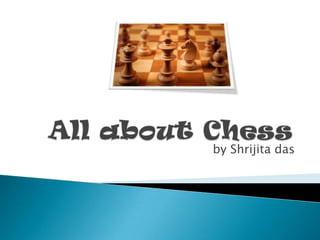
All about chess
- 3. Chess, 'the game which', says Voltaire, 'reflects most honour on human wit', arose in the fifth century A.D. in north-west India. No more precise indication can be given as to its origin and it is not known who actually invented the game. It was then called 'chaturanga' and though the game differed in some respects from the modern version it was clearly chess. No evidence exists for its having been played earlier and the
- 4. The rules differed slightly from modern chess in those times. However, by the Seventeenth Century the game had settled exactly into its modern form, from which it is unlikely to depart. An interesting encounter between the players of the modern form of chess and a player of the old Indian version occurred between 1929 and 1933 when Mir Sultan Khan became British Champion and defeated the World Champion Alkehine, and the former World Champion Casablanca.
- 7. The King The Queen The Rook The Bishop The Knight The Pawn
- 8. The king can move to any of the squares pointed to by an arrow in the diagram on the left. The king is the main chess piece. The side whose king is captured loses. This capture is called 'checkmate'. Checkmate happens once the king is under attack, cannot move and cannot be helped by its own army of chessmen.To underscore the highest value of the King relative to other pieces in a chess game, in early computer chess programs, the king was assigned a value of 200 points.
- 9. The Queen can move any number of squares diagonally and also in horizontal and vertical directions. The Queen, however, cannot jump over any pieces. The diagram on the left illustrates that the Queen can move to any of the squares pointed to by an arrow and also to any of the squares marked with red dots.
- 10. The Rook can move any number of squares in horizontal and vertical directions. The Rook, however, cannot jump over any pieces. The diagram on the left illustrates that the Rook can move to any of the squares pointed to by an arrow and also to a square marked with a red dot.
- 11. The Bishop can move any number of squares diagonally only. The Bishop, however, cannot jump over any pieces. The diagram on the left illustrates that the Bishop can move to any of the squares pointed to by an arrow.
- 12. The Knight can move from one corner to the other of any 2x3 rectangle of squares. The Knight is also the only piece that can jump over any other chess pieces. The diagram on the left illustrates that the Knight can move to any of the squares pointed to by a red dot.
- 13. From its starting square, the pawn can move or 2 squares straight ahead. If the pawn is not on its starting square, it can only move 1 square straight ahead. The diagram on the left illustrates that the pawn can move to any of the squares pointed to by an arrow and a red dot. Although pawns move only forward, they capture only sideways 1 square diagonally forward -- see diagram in Chess Rules)
- 16. DIBYENDU BARUA
- 17. KONERU HAMPI
- 18. BHASKARAN ADHIBAN SUBRAMANIAM ARUN PRASAD
Hinweis der Redaktion
- A CHESS BOARD
